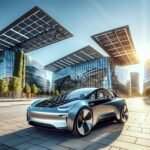Imagine powering your electric vehicle without spending a dime. With the right setup, charging your EV using solar energy can turn that dream into reality. Did you know that the average American spends over $1,000 a year on gasoline? By harnessing the sun’s energy, you can not only reduce your carbon footprint but also save a significant amount of money.
Isn’t it time to rethink how you fuel your daily commute? Transitioning to solar power for your EV charging needs not only offers financial benefits but also contributes to a cleaner environment. As you explore this innovative approach, you’ll discover how easy it can be to tap into renewable energy sources and enjoy the freedom of driving without the burden of fuel costs. Let’s jump into the world of solar charging and unlock the potential for a sustainable future.
How to Charge Your Electric Vehicle for Free with Solar Power
Charging your electric vehicle (EV) with solar power reduces fuel expenses and promotes a sustainable lifestyle. Here’s how you can start charging your EV for free.
- Assess Your Energy Needs
Determine how much energy your EV consumes. For instance, if your EV requires 30 kWh to fully charge and you drive 1,000 miles monthly, calculating your solar requirements helps in sizing your solar panels. Not sure where to start? Consider using online calculators tailored for solar energy. - Install Solar Panels
Purchase and install high-efficiency solar panels. Look for options that suit your roof space and budget. Solar Panels for Life offers versatile installations that can meet various energy demands. It’s an investment in a greener future, don’t you think? - Use a Solar Inverter
Integrate a solar inverter that converts direct current from your panels into alternating current for your EV. This technology ensures that you harness your solar energy efficiently. - Set Up a Charging Station
Install a home charging station connected to your solar system. This allows you to charge your EV using your solar energy, fulfilling the vision of a true solar lifestyle. Imagine charging your vehicle with sunshine—how liberating! - Monitor Your System
Regularly check your solar system’s performance. Monitoring apps can provide real-time data about your energy production and consumption. Catch potential issues early to keep your system running smoothly. - Use Incentives
Explore local and national incentives for solar energy installations. These can significantly reduce initial costs, making your transition to solar panels even more affordable.
Transitioning to solar energy for EV charging isn’t just eco-friendly; it’s also financially savvy. Ready to embrace a sustainable energy future? Explore your options with Solar Panels for Life today and join the growing community of solar-powered drivers.
 Essential tips to keep your solar-powered RV running smoothly
Essential tips to keep your solar-powered RV running smoothlyAsk for more INFO
Send Us a message
Understanding Solar Power for Electric Vehicles
Solar power offers a sustainable solution for charging your electric vehicle (EV). Imagine harnessing the sun’s energy to fuel your car. Sounds appealing, right? Solar panels capture sunlight and convert it into electricity, providing an eco-friendly alternative to traditional energy sources.
What Is Solar Power?
Solar power refers to the process of capturing sunlight using solar panels. These panels contain photovoltaic cells that convert sunlight into direct current (DC) electricity. Inverters then transform this DC electricity into alternating current (AC) electricity, suitable for charging your EV. By utilizing solar power, you can significantly reduce dependence on grid electricity. Why not take advantage of a renewable energy source that is abundant and free? With the right solar setup, charging your EV becomes as simple as plugging it into a regular outlet.
Benefits of Charging with Solar Power
Charging your EV with solar energy presents numerous benefits. First, elimination of electricity costs makes a significant impact on your wallet. Once you install solar panels, you harvest free energy, turning your home into a hub of sustainable living. Also, this method reduces your carbon footprint, aligning your values with eco-friendliness. Consider this: charging an EV typically involves utilizing fossil fuels through grid electricity. By contrast, solar power contributes to a cleaner environment. Beyond financial savings and environmental responsibility, using solar energy can enhance the value of your home. Homes equipped with solar panels often attract buyers looking for energy-efficient features.
Read also: Essential tips to keep your solar-powered RV running smoothly
Essential tips to keep your solar-powered RV running smoothly How solar bikes are changing the future of urban mobility
How solar bikes are changing the future of urban mobilityAs you embrace the solar lifestyle, explore how solar panels for life can transform your EV charging experience and elevate your commitment to sustainability. Why wait to power your journey with the sun’s energy?
Materials Needed
Before diving into charging your electric vehicle (EV) with solar power, gather essential materials for a seamless setup. Having the right components not only enhances efficiency but also ensures a sustainable and cost-effective solution for your energy needs.
Solar Panels
Solar panels serve as the heart of your solar energy system. They capture sunlight and convert it into electricity. Choosing high-quality panels from trusted manufacturers can significantly affect your energy production. You can opt for monocrystalline panels, which are known for their efficiency, or polycrystalline panels, which are more budget-friendly. Have you considered how much sunlight your location receives? This influences your solar panel selection and placement. Ensure ample daylight exposure for optimal performance. Eventually, investing in reliable solar panels pays off long-term in savings and energy independence.
Inverter
The inverter plays a crucial role in converting the direct current (DC) electricity generated by solar panels into alternating current (AC) electricity for your EV. Consider using a reputable inverter brand that matches your system’s capacity. Do you want to maximize energy usage? Look for an inverter equipped with monitoring capabilities, allowing you to track performance and efficiency easily. An efficient inverter ensures that you not only charge your vehicle effectively but also minimize energy loss, leading to significant cost savings. Choosing the right inverter sets the framework of a successful solar charging solution for your EV.
Read also: Essential tips to keep your solar-powered RV running smoothly
Essential tips to keep your solar-powered RV running smoothly How solar bikes are changing the future of urban mobility
How solar bikes are changing the future of urban mobility Things to know before investing in a solar-powered bicycle today
Things to know before investing in a solar-powered bicycle todayCharge Controller
A charge controller is essential for regulating the flow of electricity from solar panels to battery storage, preventing overcharging and ensuring longevity. With the right charge controller, you can manage power distribution effectively. Are you aware of different types available? Pulse width modulation (PWM) controllers are cost-effective for basic setups, while maximum power point tracking (MPPT) controllers optimize energy harvesting for enhanced efficiency. Selecting the right charge controller aligns with your solar lifestyle, ensuring safe and reliable energy management for your EV charging station.
Battery Storage (Optional)
Battery storage allows you to store excess solar energy for use when sunlight isn’t available, ensuring consistent power for your EV charging. Installing batteries means harnessing renewable energy regardless of the time of day. Think about your peak usage times; having a storage solution can decrease reliance on grid power during these hours. Lithium-ion batteries are increasingly popular due to their efficiency and compact size. Could this be the game-changer in managing your energy consumption? Investing in battery storage complements your solar panel system, enhancing your energy independence. Explore the options that align with your renewable energy goals and extend the lifespan of your solar panels and overall system.
Embracing solar energy for your EV isn’t just an investment in a car; it’s a lifestyle choice that pays dividends while contributing to a sustainable future. Ready to power your journey? Explore our collection of solar solutions designed to meet your needs.
Tools Required
Setting up your solar-powered charging station for your electric vehicle (EV) involves specific tools and equipment. Having the right tools ensures a smooth installation and effective monitoring of your system.
Read also: Essential tips to keep your solar-powered RV running smoothly
Essential tips to keep your solar-powered RV running smoothly How solar bikes are changing the future of urban mobility
How solar bikes are changing the future of urban mobility Things to know before investing in a solar-powered bicycle today
Things to know before investing in a solar-powered bicycle today Exciting new innovations in solar-powered electric vehicles you need to see now
Exciting new innovations in solar-powered electric vehicles you need to see nowInstallation Tools
- Solar Panels: Selecting high-quality solar panels is critical. These panels convert sunlight into electricity, creating a sustainable energy source for your EV. Consider installing panels from reputable manufacturers to ensure efficiency.
- Inverter: The inverter turns the direct current (DC) from the solar panels into alternating current (AC), suitable for charging your EV. Look for a robust inverter that matches your solar output levels.
- Charge Controller: This device regulates the flow of electricity from the solar panels to your EV, preventing overcharging. A proper charge controller helps prolong the lifespan of both your EV battery and the solar panels.
- Mounting Hardware: Securely mounting solar panels on your roof or ground is essential. Quality mounting hardware withstands weather conditions, ensuring stability and performance.
- Cabling: Using appropriate wiring facilitates safe connections. Pick durable cables suited for outdoor use to resist environmental wear and tear.
- Monitoring System: A good monitoring system lets you track energy generation and consumption. You can take advantage of smartphone apps or dedicated devices that provide real-time data, ensuring you optimize your solar lifestyle.
- Energy Meter: An energy meter measures how much electricity flows to your EV. This tool allows you to evaluate the effectiveness of your solar panels and adjust usage patterns accordingly.
- Battery Storage (Optional): If you opt for battery storage, select a system that integrates seamlessly with your solar setup. Batteries store excess energy for later use, meaning you can charge your EV at night or during cloudy days.
- Smart Home Integration: Linking your solar energy system to smart home devices grants you control over power usage. Smart systems can adjust settings based on energy availability, optimizing efficiency effortlessly.
Incorporating these tools not only elevates your EV charging experience but also aligns with a solar energy lifestyle. Curious about starting your journey? Explore your options with Solar Panels for Life to discover how you can effectively harness solar energy today.
Setting Up Your Solar Power System
Setting up your solar power system creates a sustainable solar lifestyle while allowing you to charge your electric vehicle (EV) for free. The right approach ensures effective energy generation and maximizes savings.
Assessing Your Energy Needs
Assess your energy consumption to determine how much solar power is necessary. Calculate how many kilowatt-hours (kWh) your EV uses monthly. For example, if your vehicle requires around 300 kWh per month, you’ll need a system capable of producing at least that amount. Consider future needs as well; planning for an increase in energy demands or additional appliances can prevent underperformance. Don’t forget to factor in seasonal variations and local sunlight conditions. How much sun does your area really receive? Tools like solar calculators can provide valuable insights. This assessment aligns your system with your lifestyle—eventually leading to an efficient charging solution.
Choosing the Right Solar Panels
Choose solar panels that meet your specific energy needs. Factors like efficiency, wattage, and warranty play crucial roles. You can find panels ranging from 250 to 400 watts, each suited for different situations and scales. Higher efficiency panels yield more energy from limited space—ideal for smaller rooftops. Always consider reliable brands with long-term warranties. With options like monocrystalline or polycrystalline panels, it’s essential to evaluate their performance in real-world conditions. Wouldn’t you prefer a robust investment with sustainability at its core? The choices you make today directly influence your future solar lifestyle.
Installation Process
Installing your solar power system requires careful planning. Start by securing any necessary permits and ensuring all local regulations are met. Use quality mounting hardware to fasten solar panels securely. Consider hiring professional installers for optimal results; they ensure the system is compliant and functional. Connect the panels to the inverter and grounding systems as per manufacturer guidelines. Integrate smart home technology for advanced energy management. This enhances monitoring and maximizes efficiency—much like a well-oiled machine, where every part is crucial for performance. The installation phase sets the foundation for a solar-powered home that effortlessly charges your EV.
Last but not least, consider exploring our selection of solar products to elevate your experience. Make that shift towards sustainability today.
Connecting the Inverter
Connecting the inverter is crucial for harnessing solar energy effectively. Start by positioning the inverter close to your solar panels. This minimizes cable lengths and energy losses.
- Mount the Inverter: Secure the inverter on a wall or support structure that allows for proper ventilation. Inverters generate heat during operation, so ensure ample airflow around them.
- Connect to Solar Panels: Using compatible DC cables, connect the solar panels to the inverter. This step often involves matching positive and negative terminals. Ensure a snug fit to prevent energy losses.
- Connect to the Power Grid: Select the right AC cables to link the inverter to your home’s electrical panel. This connection allows you to use solar energy directly while sending excess energy back to the grid.
- Install Grounding: Ground the inverter properly to prevent electrical hazards. Use a grounding rod or wire that complies with local regulations to ensure safety.
- Monitor the System: Many inverters provide monitoring software or apps. Use these tools to track energy production and assess performance. Regular checks optimize your solar lifestyle and ensure you extract maximum benefits.
Curious about real-life savings? Many users cut their electricity bills by significant margins. Imagine charging your electric vehicle entirely with free energy from your solar panels! With every successful setup, you contribute to a greener future and lower your carbon footprint. Explore more to discover how you can elevate your solar journey with us at Solar Panels for Life.
Setting Up a Battery Storage System
Setting up a battery storage system implements an effective way to maximize the benefits of your solar panels. You harness energy during sunny days and store it for nighttime charging of your electric vehicle (EV). Interested in how this works? Let’s immerse.
- Choose the Right Battery: Lithium-ion batteries are popular for their long lifespan and efficiency. Select a battery size based on your daily energy needs and solar panel output. A typical home might need a 10 kWh battery for substantial savings.
- Install a Charge Controller: Integrate a charge controller to manage the flow of energy between solar panels and the battery. This device prevents overcharging and ensures longevity. Imagine it as the traffic light that regulates energy movement.
- Connect the System: Link the battery to your solar inverter. This connection allows your stored solar energy to be converted to usable electricity for your EV. Proper wiring is crucial. Consult an expert if you’re unsure.
- Monitor Energy Flow: Carry out monitoring systems to track energy generation and consumption. Many modern setups include apps that show real-time data. Wouldn’t it be satisfying to see how much energy you’ve produced and saved?
- Use Energy Storage During Peak Times: Use stored energy to power your EV when electricity rates are highest or generate the most emissions. This strategy optimizes performance while contributing to your sustainable solar lifestyle.
Setting up a battery storage system positions you as a proactive contributor to a greener future. By harnessing solar energy efficiently, you not only reduce your carbon footprint but also enjoy significant savings. Curious about how to enhance your solar setup? Explore our offerings at Solar Panels for Life.
Charging Your Electric Vehicle
Charging your electric vehicle (EV) with solar energy brings an exciting opportunity to enhance your solar lifestyle. By harnessing the power generated from solar panels, you can enjoy significant cost savings while contributing to a greener planet.
Connecting Your EV to the Solar Power System
Connecting your EV to the solar power system starts with the right infrastructure. You need a compatible EV charger that works seamlessly with your solar setup. This connection allows your vehicle to draw energy directly from the solar panels during daylight. Imagine plugging in your EV during peak sunlight hours, maximizing the energy production from your solar panels.
For optimal results, consult a certified electrician to ensure proper installation and integration with your home’s system. Consider including a dual-port charger if you have multiple EVs. Not only does this setup streamline energy consumption, but it also makes it easy to charge both vehicles simultaneously.
Monitoring Your Charging Process
Monitoring your charging process adds another layer of efficiency to your solar energy usage. Utilizing a monitoring system lets you track the solar generation and energy consumption in real-time. With an app or display, you can see how much energy your solar panels generate and how much you’re using to charge your EV.
Rhetorical questions like, “How much are you saving each time you charge?” keep you engaged. You’ll discover patterns in your energy use. You might adjust your charging schedule based on weather forecasts. This proactive approach not only maximizes your savings but also enhances your understanding of your energy habits.
Revealing the full potential of solar panels means exploring innovative ways to charge your EV. Consider implementing these strategies to take control of your energy consumption, and enjoy the countless benefits of a greener lifestyle.
Tips for Maximizing Solar Energy Use
Maximizing your solar energy use enhances the benefits of your solar panels while ensuring efficient energy consumption for charging your electric vehicle (EV).
Using Energy-Efficient Appliances
Utilizing energy-efficient appliances reduces overall electricity consumption, allowing more solar power to charge your EV. Energy-efficient appliances often consume less power without sacrificing performance. For instance, switching to LED lighting decreases energy usage by up to 75%. Have you considered how much energy traditional appliances consume? By investing in appliances with Energy Star ratings, you actively lower demand on your solar energy system. A smaller energy expenditure means more excess energy can be used for charging your vehicle, especially when harnessing the power of solar panels effectively. Maintaining your appliances also plays a crucial role. Regular checks ensure they operate at peak efficiency, further maximizing your benefits in the solar lifestyle.
Charging During Peak Sunlight Hours
Charging your EV during peak sunlight hours takes full advantage of solar energy production. Solar panels generate the most energy when the sun shines brightest, typically between 10 AM and 4 PM. Why not align your charging schedule with this time frame? For example, charging your vehicle in the early afternoon ensures you capture the maximum output from your solar panels. This practice not only reduces costs but also contributes to a more sustainable energy model in your household. Monitoring your solar production allows you to confirm that your hardware supports this strategy. Implementing smart home technology, if available, automatically adjusts charging sessions, optimizing energy use whenever possible. Embracing this proactive approach results in substantial savings and supports your commitment to a solar lifestyle.
Explore additional strategies to optimize your energy use further while enjoying the advantages your solar energy system offers. For a deeper jump into enhancing your solar experience, visit Solar Panels for Life to discover valuable resources and tools tailored to your needs.
Troubleshooting Common Issues
When charging your electric vehicle with solar power, encountering issues can be frustrating. Here are common problems and solutions to ensure your solar charging system remains effective.
Insufficient Power Generation
If solar panels aren’t generating adequate energy, assess panel placement. Optimal positioning directly impacts efficiency. Ensure panels face the sun without obstructions. Regularly clean solar panels to prevent dust accumulation. Even a thin layer of dirt can reduce electricity production significantly. Also, check the weather forecast; cloudy days can diminish output. Did you know that seasonal changes affect solar energy generation? Fall and winter may reduce sunlight hours. Make adjustments to your energy needs during these periods.
EV Not Charging
When your electric vehicle isn’t charging, several factors may be involved. First, verify the connection between the charger and your EV. Loose or damaged cables can disrupt charging. Second, double-check your solar power settings. Ensure the inverter is functioning correctly and set to the desired charging mode. If the inverter displays an error code, consult the manual. Finally, confirm that your solar panels have sufficient energy output at the current time. Monitor generation levels; using an energy-efficient appliance during peak sunlight hours maximizes your solar lifestyle.
Inverter Problems
Inverter issues can halt your charging process. First, check the inverter’s display for error messages. They offer crucial insights into any malfunction. If you notice overheating, turn off the inverter and allow it to cool down before restarting. Regular maintenance, such as cleaning and inspecting connections, can prevent operational hiccups. Have you considered investing in a hybrid inverter? They can enhance energy management and adapt more effectively to your solar system’s unique needs. Ensure your system stays productive and efficient by addressing these potential inverter problems.
Alternative Methods for Charging
Embracing alternative charging methods enhances your solar lifestyle. These options offer flexibility in powering your electric vehicle (EV) without relying solely on your home setup.
Community Solar Programs
Community solar programs allow you to access solar energy even if your property lacks proper sunlight exposure or the ability to install solar panels. These programs let you invest in a shared solar array. Your participation means you receive credits on your energy bill based on the amount of energy produced by the solar installation. It’s an excellent solution for maximizing your energy consumption while contributing to a greener community. Think about it: instead of installing individual solar panels on your roof, you can tap into a collective source that generates clean energy for multiple households. This model offers affordability and sustainability, encouraging you to live a more eco-friendly lifestyle while charging your EV cost-effectively.
Incentives for Solar Installation
Incentives for solar installation make transitioning to solar energy more appealing. Various government programs and rebates help offset the initial costs, making solar panels a sound investment. If you’re considering a solar system, check local initiatives that cover installation expenses through loans or grants. For example, some provinces in Canada offer programs that finance solar installations with repayments tied to property tax bills. Why pass up these benefits? By leveraging incentives, you can reduce your overall investment and enhance your potential savings. Imagine charging your EV with energy produced by your solar panels while enjoying lower energy bills. This dual benefit positions solar technology as a smart financial and ecological choice, reinforcing your solar lifestyle. Explore these incentives and make your move towards sustainable charging today.
